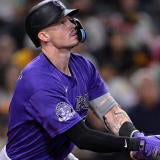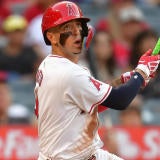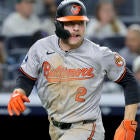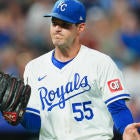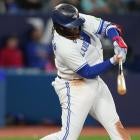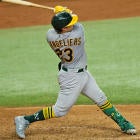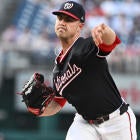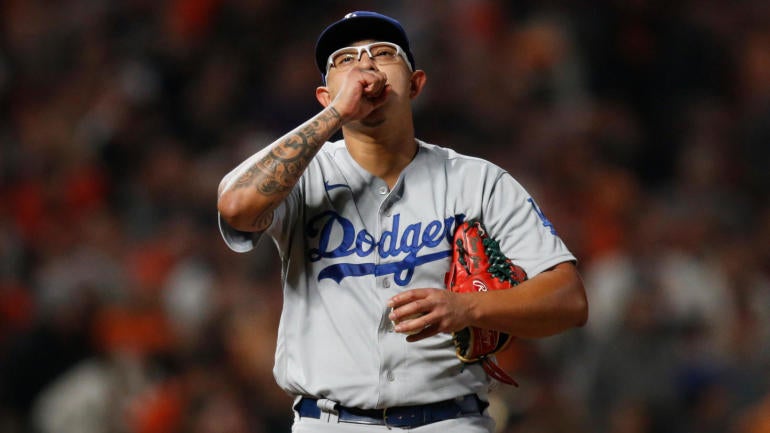
If there's one thing that's stood out among the pitchers who've made a start so far, it's how short their outings have been. Only six -- Robbie Ray, Chris Bassitt, Yu Darvish, Hunter Greene, Frankie Montas and Chris Flexen -- have thrown 90-plus pitches, with nobody cracking 100. The norm has been only 4-5 innings, as if a continuation of the normal spring training progression.
And that's basically what it's been. Spring training, after all, was only half its normal length, delayed by prolonged labor negotiations. Three weeks may be enough time to get hitters up to speed, but preparing an arm for the rigors of a starting role is a more painstaking process -- a slow and steady buildup that involves carefully increasing pitch counts, gradually introducing offspeed pitches and possibly even navigating a "dead arm" phase.
In terms of increasing pitch counts, everyone is equally behind. We all can see it and understand it implicitly, so it doesn't raise much alarm. Any struggles related to those other parts of the buildup process, though, are liable to cause a five-alarm freakout.
Take Brandon Woodruff, who allowed seven earned runs in 3 2/3 innings Saturday at the Cubs. His case may be as simple as his offspeed arsenal not being in midseason form yet given that he threw his fastball 71 percent of the time. It's a pitch he leans on more than most pitchers of his stature, but closer to 60 percent of the time than 70. If he's not giving hitters anything else to look at, it stands to reason they'll key in on that pitch.

Fantasy Baseball Today Newsletter
Your Cheat Code To Fantasy Baseball
You're destined to gain an edge over your friends with advice from the award-winning FBT crew.
Thanks for signing up!
Keep an eye on your inbox.
Sorry!
There was an error processing your subscription.
He's kind of a one-off, though. All I need to douse the flames of that potential freakout is to point out that his velocity was more or less fine, which brings us to that last variable in the buildup process: arm strength. If there's a second thing that's stood out among the pitchers who've started already, apart from how short their outings have been, it's how low their velocity has been.
The hurried buildup may not be entirely to blame. Colder temperatures -- the kind that isn't so conducive to baseball -- were prevalent in the Midwest for opening weekend. It's also possible that some of these pitchers have legitimately lost something, as has been happening to pitchers from time immemorial. But because the drop in velocity was so widespread, and not necessarily isolated to one region of the country, it stands to reason that a variable common to all could be the explanation for most.
Especially since that "dead arm" period that I referenced earlier, when a pitcher's arm first begins to buckle from the unfamiliar usage, tends to kick in about, oh, midway through spring training.
The reduction in velocity, specifically on the fastball, has been more drastic for some pitchers than for others, and I've tiered them by the extent of the dip. One point I'm trying to stress here, though, is how common the phenomenon has been. It's the ultimate tipoff that whatever is happening goes beyond the individual level, which should give you some peace of mind if you're in possession of such a pitcher. Rest assured, you're not alone.
The most concerning (down 2+ mph)
It may be a stretch to include Noah Syndergaard here given that the most obvious explanation for his decline is his recovery from Tommy John surgery, but if he's going to have to make do with 3 mph less on his fastball, it's an obvious cause for alarm. He has so far found success with it, even going back to spring training, and while he struck out only one in his season debut, he also coaxed 12 swinging strikes on 76 pitches, a strong rate by any standard. It's reason enough to hold out hope, but I do have my doubts.
Likewise, Michael Kopech's 2 mph drop is best explained by him transitioning from the bullpen to the starting rotation this year. It's not what you want to see, but it's also to be expected. While his first start was unremarkable, I'd say the jury is still out on how that transition will go.
It's the other three -- Julio Urias, Robbie Ray and Shane Bieber -- who raise the most alarm. The drop in velocity is so significant for each that it's hard to imagine them flipping a switch and getting it all back. But will they get some of it back, and will they miss what's gone for good (presuming it is)?
As for that second question, initial returns suggest Ray and Bieber won't, at least not to the extent of completely ruining them. Ray still got 17 swings and misses in his start. Bieber also got plenty of whiffs with his pair of plus breaking balls, and in his scrum with reporters afterward, most of the questions focused on how good he looked. (He was quick to dismiss the one question about velocity.)
Urias is another matter. The results in his first start -- at Colorado, it's worth noting -- were genuinely terrible, and most of the postgame chatter centered on his velocity. He averaged 91.4 mph on his fastball, a career-low for any official appearance, and it wasn't much better in his last unofficial one to end spring training. He also reported to spring training weighing 20 pounds less than a year ago, which theoretically could have an effect on his strength. In any case, he doesn't sound terribly concerned.
"It was a weird day, in every way," he said. "But I feel good physically and am ready for the next start."
Manager Dave Roberts, meanwhile, directly blamed the short spring.
"I do think it's a byproduct of just not having that normal buildup," Roberts said. "I'm not using that as an excuse. I think it's just a matter of fact. We're building him up and building up arm strength."
Maybe? I mean, we obviously don't have much precedent for this sort of thing. If there's any organization I trust to get Urias right, it's the Dodgers, presuming he's as healthy as they say. I would consider him the most concerning of any pitcher featured here, but I'm not so concerned that I'm ready to unload him for 75 cents on the dollar. In fact, when someone offered me Urias for Max Muncy immediately after Sunday's start, I hit accept.
Moderately concerning (down 1.5 to 1.9 mph)
The name who stands out here is Eduardo Rodriguez, who was lights-out in spring training, showing no cause for concern with the fastball, so he might be the clearest example of "dead arm" coming into play. Either that or he suffered an injury somewhere along the way that has yet to be discovered.
I'm including Aaron Civale with this group because, while his fastball was down "only" 1.4 mph, he barely threw it. His most-used pitch, a slider, was down 4.3 mph, and right behind it was the cutter, down 3.2. I'd say that's at least moderately concerning, but what makes it especially curious is that his entire pitch selection was different from a year ago. Perhaps he's remade his arsenal only a year after remaking his delivery. The man loves to tinker, making it hard to pin down exactly what's wrong with him if anything.
What's curious about the rest of this group is that their performance didn't suffer from their velocity. Yeah, Josiah Gray wasn't great, but keeping the ball in the yard has been a problem for him no matter how hard he's throwing. The rest are all pretty fringy (with the possible exception of Sonny Gray), so it wouldn't take much to render them irrelevant. Then again, none of them is renowned for his fastball either, so perhaps it won't have the greatest say in what happens next.
Also noteworthy (down 1 to 1.4 mph)
A velocity dip in this range offers the most hope for a full correction, though it's obviously no guarantee. In the case of someone like Ian Anderson, it's likely his whole delivery was out of sorts given that he also walked five in his 2 2/3 innings of work. That's another potential consequence of the shortened spring training. Some pitchers may not have had a chance to get comfortable with their mechanics -- run a full diagnostic, if you will -- which will of course have an impact on velocity.
John Means is more of a control-and-command specialist who put to rest any hope of being a significant bat-misser last year, so a modest drop in velocity may not matter so much for him. Anthony DeSclafani also fits into that category, if to a lesser extent. What's interesting about Walker Buehler is that much of the Dodgers staff experienced similar declines in velocity -- not just Urias, but also relievers like Craig Kimbrel, Blake Treinen and Daniel Hudson. Maybe it has something to do with pitching in Colorado, or maybe the Dodgers were especially careful not to ramp up their pitchers too quickly, as we also saw in the lead-up to the pandemic-shortened 2020 season.
Sean Manaea wasn't at all fazed by the dip seeing as he threw seven no-hit innings at the Diamondbacks, which is especially notable given that a velocity bump was largely credited for his breakthrough last year. We'd still like to see it return to those levels, of course, but there's obviously no cause for alarm as of yet.
































